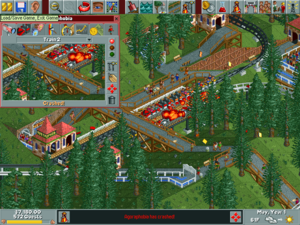Diamond Heights is already a thriving park with a couple of associated Steel Roller Coasters named "Agoraphobia", "Claustrophobia", and a Steel Mini Roller Coaster named "Arachnophobia". There are a number of other rides including a Wooden Crazy Rodent Roller Coaster, a Log Flume, a Miniature Railroad, a Merry-Go-Round, and a Spiral Slide. The park already has a respectable value that's over $13,000, but the goal is to increase it to at least $20,000.
Increasing park value requires two things: new rides and high ratings. The more expensive the ride, the greater impact it has on park value. The downside is that the longer that a ride stays operating, the lower the park value drops. Building complex rides such as roller coasters, log flumes, or miniature railroads will have a greater impact than building a carousel or a swinging ship. After some time, you should delete and replace old rides with brand new rides to increase park value. Of course, deleting rides will severely impact it as well, so be absolutely sure you have enough money to do the replacement. Keeping the guests happy is also important as the park's rating also affects your value. A poorly rated park wouldn't be worth much to a guest, so it also wouldn't be worth much to people that want to invest in your park.
Diamond Heights already has several functioning rides, but it's missing food stands, drink stalls, and bathrooms. There are a sizable amount of guests starving when you start, so build a series of food shops scattered around the park. Do not place food near the roller coasters or there will be vomit all over the paths. Although the shops don't cost very much, the guests' happiness will increase the value so it more than covers the shops' worth. Because drink stalls are not initially available, set the research priorities to shops and stalls and give it maximum funding until drink stalls can be made. Once this is unlocked, redirect the research toward thrill rides and roller coasters.
As for your staff, hire three more handymen and make sure some of them are directed toward the roller coasters, especially the Wooden Crazy Rodent Roller Coaster as it has a high nausea rating of 5.36. The mechanics already have designated areas to ensure that they're not roaming around too far away from important rides, but if you feel that they're stretched too far, modify them with the blue footprint button on the staff member's window. Set the roller coasters to be inspected every ten minutes as well to keep their reliability from decreasing too much.
The rides in the park itself are generally well made, but several improvements and precautions should be implemented. The first of these is to change the number of rides in Shortstuff's Slide. Lowering the number of rides will decrease the excitement, but will help prevent long queue times and people complaining that they want to get off. The second precaution involves the log flume, Snake River Falls, which has a very long queue for a very long ride. Hire an entertainer to patrol the line to keep guests from getting bored or shorten the queue line to ensure guests don't spend most of their time waiting. Guests only have so much patience, so if they wait too long, they will leave the line in frustration.

Finally and most importantly, there's Agrophobia and Claustrophobia. Because these rides have two trains, if a station brake failure occurs, one of the trains could fly through the station and slam into the other one in an explosion. If this occurs, you will either have to demolish it, which will cut deeply into the park's value, or wait until people forget about the accident, which takes several in-game months. There are two ways to prevent this. The first is to set the time between inspections to 10 minutes for each ride and have a mechanic on patrol around the area. The second is to simply change the number of trains on each ride to one, which requires closing and retesting the ride. Having only one train means there's nothing to crash into if a station brakes failure occurs. In addition, set the number of cars per train to the maximum of 8. This will slightly raise the excitement value while keeping the guest throughput high. Either way, remember to save the game often so that if a disaster occurs, you won't have to go back too far.
The four roller coasters in the park should be plenty to make the value quota, but building another one or two can help you reach your goal faster. Due to how successful the park starts as, profits should be rolling in fairly quickly, giving you plenty of money to work with. The bigger challenge is the hilly terrain, abundance of water, and existing roller coasters that will get in the way of construction, but what is a scenario without a challenge? If funds are somehow low, build go kart tracks and water slides instead. They are relatively cheaper. but have a great impact on your park value regardless.
While the goal is to double the park's value, it doesn't necessarily mean that the park must be doubled in size. Keeping the guests happy while building a few new rides does wonders to the park's value. If the time limit is drawing to a close and you don't have the required park value, consider building a bunch of small gentle and thrill rides around your park. The combination of new rides and the cost of each ride should put you well over the mark.
